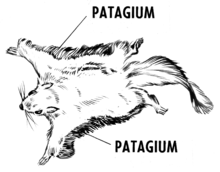Patagium

The patagium (pl.: patagia) is a membranous
Bats
In bats, the skin forming the surface of the wing is an extension of the skin of the abdomen that runs to the tip of each digit, uniting the forelimb with the body.
The patagium of a bat has four distinct parts:
- Propatagium: the patagium present from the neck to the first digit.
- Dactylopatagium: the portion found within the digits.
- Plagiopatagium: the portion found between the last digit and the hindlimbs.
- Uropatagium: the posterior portion of the flap between the two hindlimbs.
Pterosaurs
In the flying pterosaurs, the patagium was composed of the membrane forming the surface of the wing, supported primarily between the body and the elongated fourth finger.
The patagium of a pterosaur had three distinct parts:[1]
- Propatagium: the anterior-most membrane, extending from the shoulder to the wrist. Pterosaurs developed a unique bone to support this membrane, the pteroid.
- Brachiopatagium: the main flight surface, stretching from the elongated fourth finger to the hindlimbs.
- Uropatagium or cruropatagium: the posterior-most membrane occurring between the two hindlimbs.
- A laser-stimulated fluorescence scan on Pterodactylus also identified a membranous "fairing" (area conjunctioning the wing with the body at the neck), as opposed to the feathered or fur-composed "fairing" seen in birds and bats respectively.[2]
Gliding mammals
) or on the wrist (flying squirrels).Other
In
In
The scansoriopterygid dinosaurs Yi and Ambopteryx had rather elaborate, superficially bat-like patagia in the forelimbs, unique among dinosaurs. The exact extent is not clear, but they were extensive and supported by a long styliform bone as in gliding mammals. Other scansoriopterygids might have had similar patagia, based on their long third fingers.[citation needed]
See also
- Volaticotherium – Extinct family of mammals
- Yi (dinosaur) – Extinct genus of dinosaur
- Ambopteryx – Genus of scansoriopterygid dinosaur
- Wingsuit flying – Variant of skydiving that uses jumpsuit with webbed sleeves, which mimic the patagia of flying mammals
References
- S2CID 51960058.
- PMID 34663691.
- PMID 9488912.
- ProQuest 2464208012.
- ISBN 978-0-12-374299-5.[page needed]
- ISBN 978-0-12-407503-0.[page needed]
